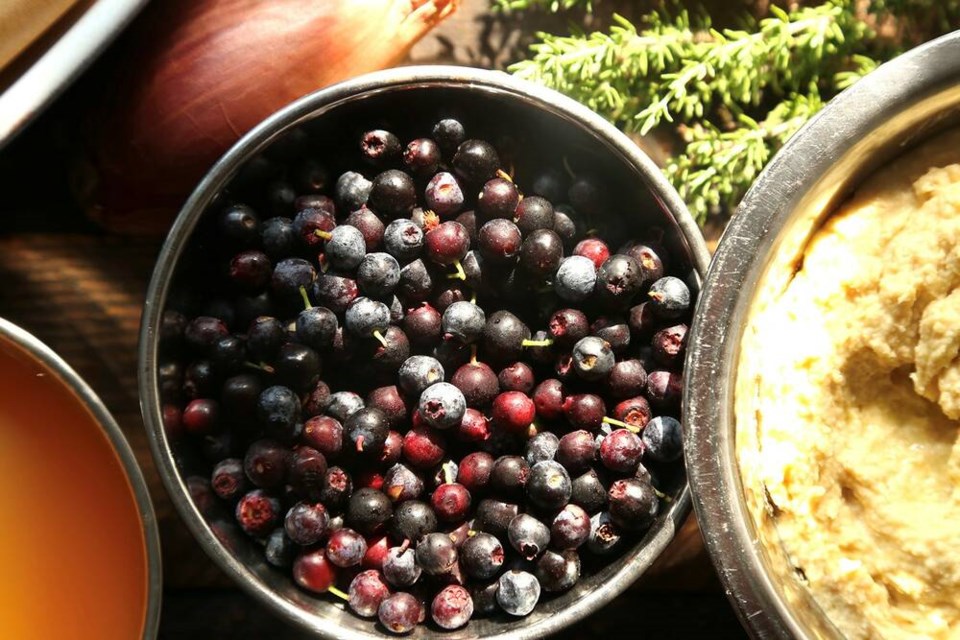With increasing frequency, readers inquire about plant stress related to climate change and extreme weather. Indeed it is hard to miss the signs – the dead and dying cedars in hedges and in stands, the sunburned leaves and flowers, and the patchwork of brown lawns.
I see it too in our berry patch. As the season progresses, the small green non-native berries that would under normal circumstances plump up as they ripen, will instead conserve resources and mature in more diminutive size. Indeed I will mulch more, even introduce partial shade, but there is little to be done about the heat.
So what can we do? We can change both our expectations and our plantings, deferring to nature’s logic. We can incorporate more native species that thrive in our landscapes, and reserve smaller areas for non-native and ornamental plants.
Humans have evolved alongside highly nutrient-dense wild foods, yet we have overlooked these in favour of exotic and non-native species that not only don’t suit our climate, they don’t suit our biology.
Like many people, we inherited the lawn, the boxwoods and the laurels. And like many people, we struggle with the non-sensical nature of enforcing our will to keep it all green, tidy and trimmed. Slowly though, we are making changes for the better.
Last summer we completed a boulevard transition that involved removal of lawn, and planting of two different native ecosystems. In one area, under a very large mature pine tree, we created a woodland garden including highbush cranberry, Indian plum, snowberry, lingonberry, wild roses, goat’s beard, ferns and dwarf pine. A deep carpet of native mulch helps keep water in place, and provides habitat for biology and fungi that support the entire system.
A narrow path winds through the tiny ecosystem in the making, and already we can feel the drop in temperature and increase in humidity as water cycles through the system instead of evaporating as it did when covered with lawn, struggling to thrive in an inhospitable environment.
On the opposite side of the driveway, where there was no established keystone tree to consider, we started from scratch, creating a Garry oak ecosystem that while beautiful in its infancy, should one day provide crucial habitat for 800-plus species of insects, birds and small mammals. Already, the boulevard is teeming with wildlife and birdsong and wild food enough for all of us.
Going wild does not necessarily mean resigning to messy or unkempt. On the contrary, classical landscape design principles can ensure that a native habitat can become every bit as beautiful as one populated with exotic species.
Few things make me happier than visiting our new ecosystems early in the morning, sitting on the small bench and listening to the hum and the thrum, and watching the wildlife. The community is small for now, starting deep in the soil and reaching up into the canopy – the microbes and the insects, the birds and the bees. Where once there was nothing, there is life and there is hope.
And indeed there is food – nutrient-dense wild and delicious food in season, to nourish our bodies, our spirits and our minds. This week, we harvested Vaccinium ovatum, evergreen huckleberries, to include in a high-protein, nutrient-dense menu, rich in phyto-chemicals and concentrated flavours and colours.
Unlike ornamental boxwoods, the beautiful native huckleberries offer sustenance along with beauty. Growing up through a carpet of Arctostaphylos uva-ursi, a.k.a. bearberry, beneath the fledgling Garry oaks, and standing in classical symmetry bordering a traditional stone path, evergreen huckleberries play a role in our ecosystem.
From just 20 small shrubs the birds and my family will feast for weeks.
Laura Marie Neubert is a West Vancouver-based urban permaculture designer. Follow her on Instagram , learn more about permaculture by visiting her website or email your questions to her here.
For a taste of permaculture, watch the video below:



